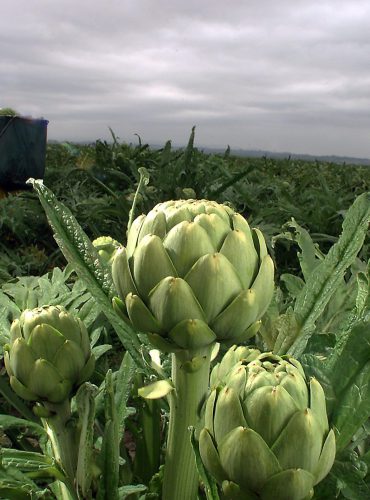Castroville
Castroville is a census-designated place in Monterey County, California, United States. At the time of the 2010 census the population was 6,481.
Castroville is known for its artichoke crop and for the annual Castroville Artichoke Festival, leading to its nickname as the “Artichoke Center of the World”.


More details
Rancho Bolsa Nueva y Moro Cojo
Rancho Bolsa Nueva y Moro Cojo was a 30,901 acre Mexican land grant given in 1844 by Governor Manuel Micheltorena to Maria Antonia Pico de Castro (Juan Bautista Castro’s Mother.)
The Rancho Bolsa Nueva y Moro Cojo is a combination of three land grants. “Rancho Moro Cojo,” granted by Governor Luis Antonio Arguello in 1825. The second is “Rancho Bolsa Nueva,” by Governnor Mariano Chico in 1836. The third was granted by Governor Juan Alvarado to Simeon Castro (Juan Bautista Castro’s Father) in 1837.
Lake Merritt and the sloughs were popular for fishing and hunting. The area around Castroville was crisscrossed by a network of sloughs and swamps.
In the 1840s, mapmaker Duflot de Mofras, wrote, “A few leagues before reaching the “Pajaro River”, an area measuring a few hundred meters where the round trembles under the horses feet, although the earth is hard and covered by turf, is encountered.
The land is probably formed by a solid crust superimposed on a vast miry base.”
Castroville, 1800+
Lots were divided into 50 by 130 feet, an alley ran through each block. A lottery was established and 100 lots were given away to any person who would clear land and build homes.
In 1870 Manuel R. Merritt, the editor of the newspaper Castroville Argus (1869–1880) announced, “We will give alternate lots, on any part of the town site we still own… to any person who will build as practicable, a good comfortable dwelling house on his lot.
Juan Bautista Castro would run for county supervisor for the district. Castro, Merritt, Geil and others traveled to the oldest settlement of Sotoville in Salinas, that is where the Indians and Paisanos lived. They packed their belongings, it was said Castro packed the tortilla cast iron pans, personal items and moved the people to Juan Pomber’s hotel for ninety days.
They were registered and became ready to vote. They were not able to read in English, so the ballots were translated for them.
Juan Bautista Castro won the office of supervisor of his district. Juan Pomber became Road- Master of the district. The county supplied money and low income housing was built on the donated lots. Castroville now had residents and a community.
In 1875 Castroville had 900 residents. There were two hotels, five stores, stables, three saloons, flour mill, two blacksmith shops, newspaper (Castroville Argus), post office, telegraph office, drug store, tailor shop, shoe-maker, two churches, a school house, tin shop, and a brewery.
The Southern Pacific Railroad began extending the line south from Gilroy. Juan Bautista Castro had ambitions of Castroville becoming the new Station Freight Depot. Castroville’s asking price for the land was high. Salinas offered the land for free, and was selected over Castroville.
Castroville was still considered an important stop, serving as the “point of juncture of the road from Monterey, and from Soledad to San Francisco.” The first roundhouse was built here in Castroville.
Real Estate Market Report
- Aromas
- Aromas, Las Lomas
- Big Sur
- Carmel
- Carmel Highlands
- Carmel South Coast
- Carmel Valley
- Castroville
- Corral de Tierra, San Benancio
- Fort Ord
- Gonzales
- Greenfield
- Highway 68 & River Road
- Indian Springs, Pine Canyon
- King City
- Las Palmas Ranch
- Marina
- Marina & East Garrison
- Monterey
- Monterey & Del Rey Oaks
- Monterra Ranch
- Moss Landing
- North Monterey County
- Oak Hills
- Pacific Grove
- Pasadera, Laguna Seca, Bay Ridge
- Pebble Beach
- Prunedale
- Salinas
- Seaside/Sand City
- Soledad
- South Monterey County
- Spreckels
- Toro Park, Serra Villiage, Creekside
